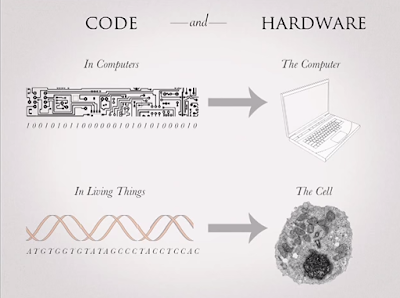Unlike many people my age that tend
to be a bit uncertain about what they want to apply their expertise on in the
future, I have always had a dream scenario for what I will be working on in
the future: DNA printing and engineering organisms for applications beyond only those
that are medical. To clarify, I find the medical applications of many projects
I have come across in my time at MIT fascinating and definitely plan on
exploring my interests for these projects throughout my career. However, I am also
extremely excited about the future of synthetic gene design for other purposes.
Currently, there is little to no focus that I've noticed in industry towards
designing DNA from scratch, except for a few small start ups.
One of the
companies that I feel best embody my interests is called Cambrian Genomics. The
founder, Austen Heinz, has a presentation posted on Youtube (linked here) that captures the
essence of what I hope will become more of a focus in biological engineering
over my lifespan. In the video, he makes an analogy between programming and
gene design. He notes that transistors used to cost a dollar each, and that writing
computer code was extremely expensive and not something most people could
pursue. Similarly, biotech companies like Lifetechnologies currently synthesize
genes for about 30 cents per base pair, meaning that it would cost hundreds of
thousands of dollars to synthesize a 1.5 million base pair bacterial genome,
making it expensive to design genes from scratch. This huge cost is multiplied
by the thousands when one takes into account the fact that the best computer models for protein
folding are currently only capable of identifying a range of possibilities for
how proteins might fold, or a pool of sequences that might result in a protein
folds in a desire way. This means that a modern-day DNA programmer would have
to spend hundreds of thousands of dollars on each one of his or her thousands
of candidate genomes, which is monstrously costly and unfeasible.
However, Heinz
also discusses some of the applications of synthetic biology which may
provide incentive for scientists to develop cheaper ways to synthesize genomes. Among the
more pie in the sky ideas that he mentions are the idea that we could resurrect
extinct animals (for applications unknown), and the idea that we could create microorganisms that would help us colonize mars. Among the more grounded but equally-exciting
applications he mentions of cheap DNA printing is the production of
personalized drugs.
I am very
eager to try to get my foot in the door with some of these rising start ups, and
hope to even found my own DNA printing company someday when I have the
resources.

No comments:
Post a Comment
Note: Only a member of this blog may post a comment.